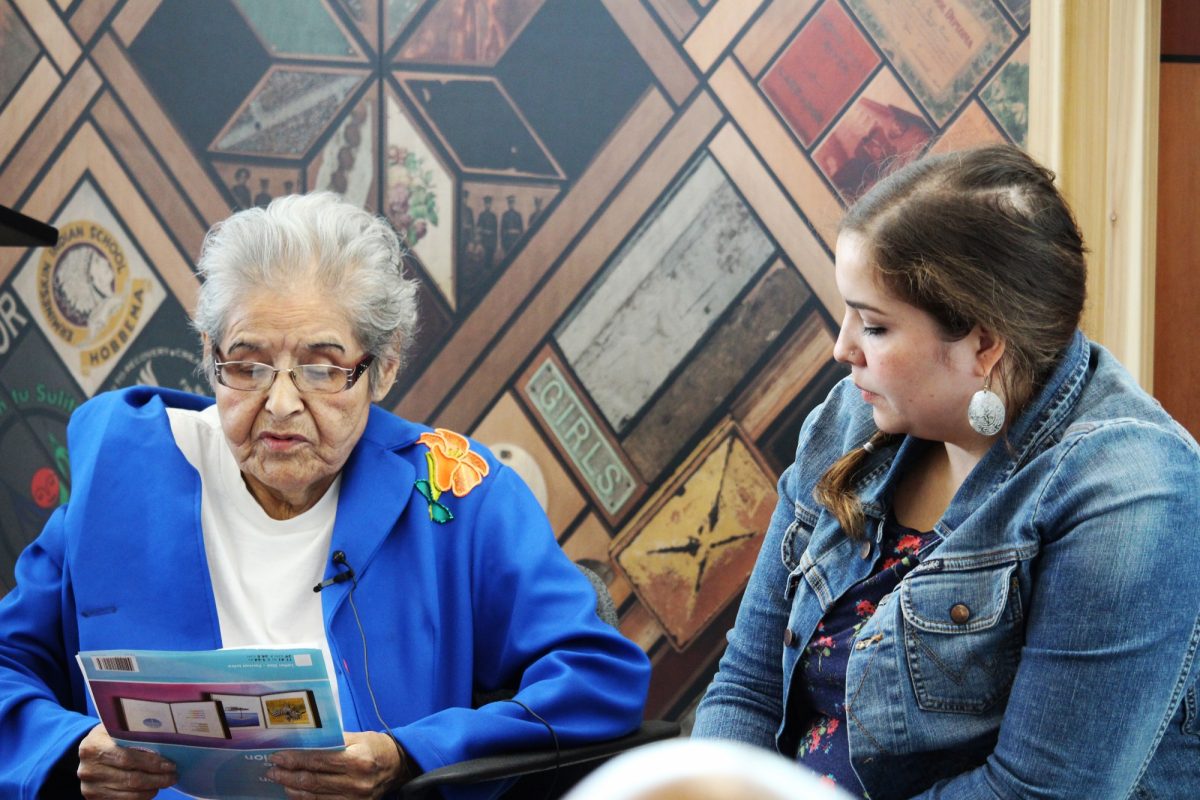
Ann Thomas Callahan (L), a residential school survivior and retired nurse, speaks at the Witness Blanket @ Bannatyne opening
Residential school survivor shares story at Witness Blanket opening
The Witness Blanket exhibition, an art installation created by master carver Carey Newman, documents the impact of residential schools through objects reclaimed from the residential schools, band offices, communities, churches, government and other traditional and cultural structures from across Canada.
The stories the items tell were the focus at the opening August 22 at the Neil John Maclean Health Sciences Library of a large scale reproduction of The Witness Blanket created by Newman and the Canadian Museum for Human Rights.
Keynote speaker Ann Thomas Callahan RN, BA, MA, Wapiskisiw Piyésís Iskwéw (White Birdwoman), a residential school survivor and retired nurse, shared her life’s story.
Born in 1935, Callahan spent 14 years in residential school. Callahan recounted her experience, highlighting the poor living conditions, lack of nourishment, disease, death and physical and sexual abuse that occurred in these institutions. It is estimated that 150,000 Indigenous people from across Canada were forced to attend residential schools.
She said that before her son passed away, he urged her to tell her story.
“He said, ‘Mum, I want you to keep on going. You go talk to the young people. Maybe you’ll make a difference in their life.’”
After graduating from the Birtle Indian Residential School, Callahan enrolled in the Winnipeg General Hospital’s three-year nursing program. In 1958, she was one of the first Indigenous nurses to graduate from the program and spent nearly 40 years in the nursing field before retiring. Throughout her career she was a strong advocate for Indigenous patients.
At the opening, Dr. Brian Postl, dean, Rady Faculty of Health Sciences, addressed the crowd, pointing to progress such as the admittance of 15 Indigenous students into the Max Rady College of Medicine this fall, the highest to date for a University of Manitoba medicine class, and the creation of an anti-racism position within the faculty.
“This exhibit can serve as a reminder of how we have to keep going,” Dr. Postl said.
Dr. Catherine Cook, vice-dean, Indigenous Health at the Rady Faculty of Health Sciences, encouraged people to come and view the exhibit.
“I wanted to bring it here on campus to share those children’s stories and continue on our path as a faculty and university towards reconciliation,” Cook said.
This exhibition is an opportunity for University of Manitoba students, staff, faculty and community visitors to the Bannatyne Campus to reflect upon the stories of the people affected by residential schools and the impact of the residential schools on survivors, their families, future generations and communities.
Pointing to the future, Callahan said to look for the positives – young Indigenous people are increasingly getting education and taking part in cultural ceremonies.
She directly addressed young people in the crowd going into a health profession.
“Make sure your client or patient understands your mission. Sometimes our people don’t want to ask, maybe they think you’re too busy, or they don’t want to show that they don’t have education. I say, if we afforded Brian Sinclair that dignity, he’d still be with us,” said Callahan.
In closing, she imparted the following: “I wish you well, you young people. The world is waiting for you.”
The Witness Blanket @ Bannatyne exhibition will be open to the public and school groups from August 22 to October 31, 2019. Hours: Monday to Friday from 8:00 am – 5:00 pm.
Neil John Maclean Health Sciences Library (300 level), 727 McDermot Avenue
For more information on group visits, contact:
Janice Linton, Indigenous Health Liaison Librarian, Neil John Maclean Health Sciences Library
janice.linton@umanitoba.ca







I really appreciate this types of stories of healing, resilience, and positivity. Thank you.